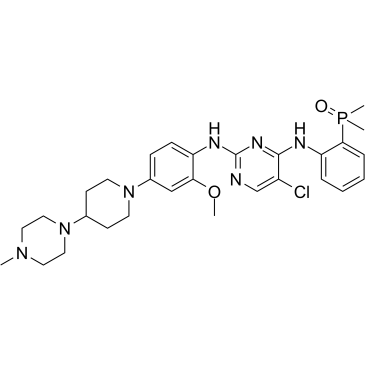| Cas No.: | 1197953-54-0 |
| Chemical Name: | 2,4-Pyrimidinediamine, 5-chloro-N4-[2-(dimethylphosphinyl)phenyl]-N2-[2-methoxy-4-[4-(4-methyl-1-piperazinyl)-1-piperidinyl]phenyl]- |
| Synonyms: | AP-26113;AP26113;AP 26113 |
| SMILES: | CN1CCN(C2CCN(C3=CC=C(NC4N=CC(Cl)=C(NC5=CC=CC=C5P(=O)(C)C)N=4)C(OC)=C3)CC2)CC1 |
| Formula: | C29H39ClN7O2P |
| M.Wt: | 584.0924 |
| Sotrage: | 2 years -20°C Powder, 2 weeks 4°C in DMSO, 6 months -80°C in DMSO |
| Description: | Brigatinib is a highly potent and selective ALK inhibitor, with an IC50 of 0.6 nM. |
| In Vivo: | Brigatinib (10, 25, or 50 mg/kg once daily, p.o.) leads to a dose-dependent inhibition of tumor growth in ALK+ Karpas-299 (ALCL) and H2228 (NSCLC) xenograft mouse models. Brigatinib markedly enhances survival of mice bearing ALK+ brain tumors compared with crizotinib[1]. Brigatinib (10, 25, 50 mg/kg, p.o.) results in dose-dependent antitumor activity, with tumor regressions in a mouse model of NSCLC[2]. |
| In Vitro: | Brigatinib potently inhibits the in vitro kinase activity of ALK (IC50, 0.6 nM) and all five mutant variants tested, including G1202R (IC50, 0.6-6.6 nM). Brigatinib demonstrates a high degree of selectivity, only inhibiting 11 additional native or mutant kinases with IC50 <10 nM. These include ROS1, FLT3, and mutant variants of FLT3 (D835Y) and EGFR (L858R; IC50, 1.5-2.1 nM). Brigatinib exhibits more modest activity against EGFR with a T790M resistance mutation (L858R/T790M), native EGFR, IGF1R, and INSR (IC50, 29-160 nM) and does not inhibit MET (IC50 >1000 nM). In cellular assays, brigatinib inhibits ALK and ROS1 with IC50s of 14 and 18 nM, respectively. Brigatinib inhibits FLT3 and IGF-1R with about 11-fold lower potency (IC50, 148-158 nM) and inhibits mutant variants of FLT3 and EGFR with 15- to 35-fold lower potency (IC50, 211-489 nM). Brigatinib inhibits cell growth with GI50 values ranging from 503 to 2,387 nM in three ALK-negative ALCL and NSCLC cell lines[1]. Brigatinib inhibits ALK activity and abrogates proliferation of ALK addicted neuroblastoma cell lines, with IC50 of 75.27 ± 8.89 nM. Brigatinib inhibits both the ALK-I1171N and the ALK-G1269A mutant receptors at 10 and 4 nM levels, respectively[3]. |

 To enhance service speed and avoid tariff delays, we've opened a US warehouse. All US orders ship directly from our US facility.
To enhance service speed and avoid tariff delays, we've opened a US warehouse. All US orders ship directly from our US facility.




















